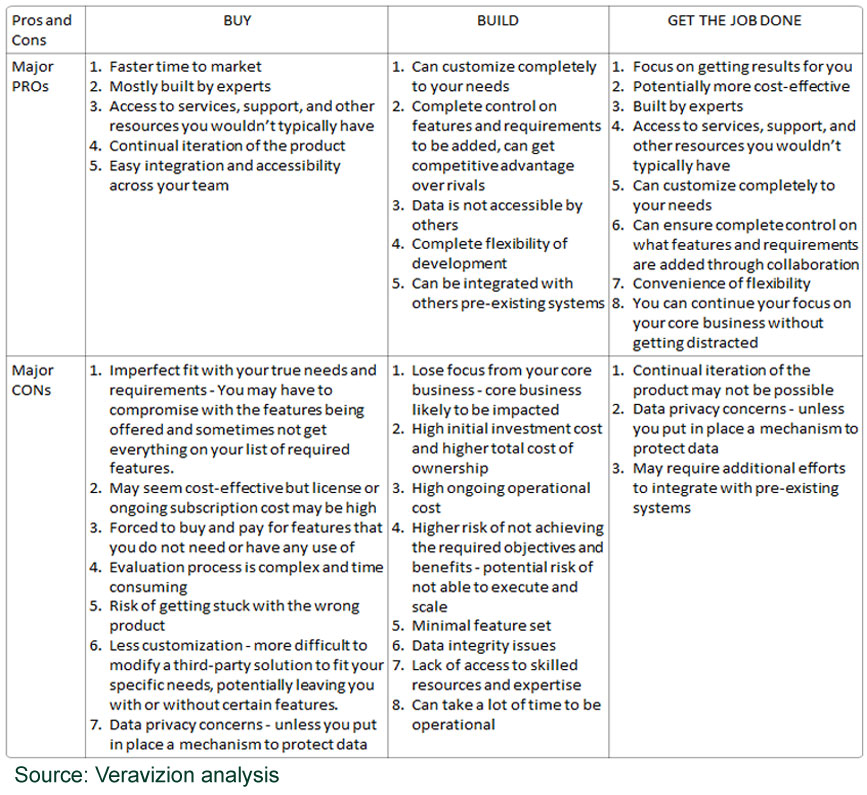A s a CxO considering analytics solutions for your organization, whether to buy or build is invariably the first perplexing question you will face. There are many reports out there that evaluate these options and propose one of them.
For a business, it is of paramount importance to get a system designed and developed that meets the organization’s strategic goals. On the Buy↔Build spectrum, ‘buying a solution and twisting it to force a fit with your requirements’ is rarely an ideal way for most clients to meet their real requirements. On the other hand, it is often costly to ‘build your own thing’ in terms of time, money, and effort.
We would like to look at the buy-or-build decision from a broader perspective.
We believe that this decision depends upon two main questions:
1. Who is making the decision? The size and type of organization making the decision.
2. What is their purpose? The benefits for which the organization is making the decision.
The business needs of a multinational corporation are vastly different from those of a small and medium enterprise (SME) or those of a neighbourhood store. Moreover, the purpose for which such a solution is required by these businesses is also very different. While a large corporation may be willing to invest huge amounts of resources in such an initiative to seek strategic benefits, an SME might just want to implement it as a one-time project with tactical benefits in mind. In short, it depends on what job each business wants to get done. Therefore, we have identified a third option, which is becoming more popular, to acknowledge the real needs that most corporations have but tend to think only in terms of ‘Buy’ or ‘Build’. We call it the ‘Get-the-job-done’ option. So before we delve deeper into the details of buy, get-the-job-done, and build, let us start on the same page in terms of what each of these decisions mean:
A] The ‘BUY’ decision: Buying a product off-the-shelf or buying a license to use a product with little or no customization. In general, the product is licensed by the vendor or a subscription-fee is charged for its recurrent usage.
B] The ‘BUILD’ decision: Setting up an in-house team of technically skilled resources to develop a product yourself from scratch. This decision entails upfront investment in terms of recruiting the right-skilled resources, training them, deploying the necessary technical infrastructure, and having an overhead team of managers to supervise the development efforts to ensure that the product is developed as envisaged.
C] The ‘GET-THE-JOB-DONE’ decision: This decision involves hiring an analytics services provider to achieve your specific requirements, be it strategic or tactical. Such initiatives usually begin as a tactical project but go on to become strategic in nature once the initial results are visible.
In order to make this decision, you need to evaluate your requirements on the following five mutually exclusive but collectively exhaustive parameters:
a. Scale of operations
b. Benefits sought
c. Total cost of ownership (TCO)
d. Availability of resources – skilled people, time, infrastructure
e. Risk tolerance
So let us look at each option in detail.
A] When and why should you consider the BUY decision?
The BUY option should be pursued whenever the focus is on acquiring a product with standard specifications, quickly.
a. Scale of operation is very small. For a small business operating in a neighbourhood, the requirements are usually generic. If you are running a corner-shop, like a coffee shop or a sandwich-bar, some standard products are generally available. These ready-made solutions address most of your broad requirements. Level of customization sought is low. So you can run your business effectively with least modifications in a standard product as it matches most of your needs. Your customization requirements are not high enough to warrant investment for a customized product.
b. Benefits expected are generally (but not necessarily) tactical in nature. A small business, like a fashion accessories corner-shop, is generally looking for a quick turnaround of inventory or brisk sales during festival season. As time is of essence, you do not have the luxury to build a custom solution. In such cases, you should go for a ready-made product.
c. Lack of skilled technical resources may be the key factor in deciding against going for a custom solution.
d. Micro businesses typically have budget constraints. As a result, it is not economically feasible for you to build a proprietary solution. You may find it more logical to buy a cheaper commercial off the shelf (COTS) product instead.
e. Risk tolerance is not high. A couple of wrong decisions might result in big setbacks to a micro-business hence it is always prudent to go for a well-proven solution that does not cost a lot of money.
B] When and why should you consider the BUILD decision?
The BUILD option should be pursued whenever the focus is on addressing the strategic objectives of the large organization and cost is not the immediate concern.
a. Scale of operations is enormous. A multinational corporation with global operations, like a financial institution or a telecom company, generally has numerous product lines targeting multicultural consumers worldwide. These businesses require a solution that has functionalities appropriate to satisfy the disparate needs of their diverse customer segments. So a high level of customization is required by large corporations. COTS products with standard specifications are rigid to modifications and cannot meet these specialized needs. Hence a proprietary solution may be better equipped to address your business scalability concerns.
b. Benefits expected are predictably strategic in nature. As a CEO of a large corporation, like a multinational retail chain or a consumer products company, you are constantly looking for distinct competitive advantage to outperform your rival(s). To gain that edge, you cannot rely on the same off-the-shelf product bought by your competitors; you need an analytical solution that is tailor-made to optimize your business specific processes and operations. Devising your own customized system is likely to give you the competitive advantage in the long run.
c. Availability of resources – people, infrastructure, and time – is pivotal to building a truly productive solution. You must recruit right-skilled people viz. data scientists, analysts, and analytics experts, and train them to form a cohesive team. This team will have to be deftly led by able managers in order to build great analytical systems and tools, in a timely manner. In today’s fast changing world, the development team will have to be agile in incorporating changes in the system to keep with the technological pace in order to outplay the competitors.
d. Total cost of ownership (TCO) in case of custom-built solution is typically high. A large organization going for the build option will need to invest heavily in order to extract the strategic benefits to the fullest. These big companies are able to do so thanks to their deep pockets. That’s why the in-house ‘build’ option is suitable primarily for the large corporations.
e. There is a discreet risk involved in heavy upfront investment. Large corporations deploy an in-house team of developers expecting large gains at a later date. However, many things can go wrong, say, the technology may itself become obsolete, or the actual gains may not be worth the time and efforts. Moreover, in-house analytics team may distract the company away from its focus on the core business. Nevertheless, large cash-rich corporations acknowledge these risks and have a high tolerance to bear them.
C] When should you decide to just GET THE JOB DONE?
This option is fast emerging as the preferred alternative among SMEs and even some large organizations as it takes away the complexity and enables you to compete on analytics in a cost effective way. You should decide to hire analytics service provider whenever the focus of your organization is on getting results – cost-effectively and with lower risk.
a. Size of operation varies between a micro-scale and a global business; small and medium sized enterprises (SME) fall in this category. For an SME operating at a regional or a national level, the business needs vary tremendously because the target customer segments differ a lot. An off-the-shelf product that is rigid to modifications is invariably unsuitable for your needs. A ready-made product only means you have to forcefully fit your requirements to the features provided by it. Hence buying an off-the-shelf product is not a sensible approach because you do not want to end up paying your hard earned money for features your business does not want. If you are running a small or medium sized enterprise, like a retail furniture store, a retail consumer goods shop, or a B2C services company, level of customization required by your business is quite high. You need a solution that is flexible to frequent changes. Therefore, an analytics partner is ideal for you to help meet your true needs.
b. Benefits are expected quickly and in a cost-effective manner as the focus is to win quick results. As a business leader running an SME, you want to keep your focus on your core business. You really need a partner that provides flexibility, gives option to customize your requirements, and works for your success while ensuring good customer service.
c. Total cost of ownership (TCO) is comparatively low if you are employing an analytics service provider. They will offer customer service in deploying the solution and training your staff, so you save on the maintenance and training costs otherwise incurred in case of buying or building a product. That’s how the get-the-job-done option reduces your total cost of ownership.
d. Resource requirement is minimal for you if you go for analytics services partner. If you do not have a team of skilled resources to develop your own analytics solution, then it would be a wise decision to hire an analytics partner who will have expertise to productively work towards achieving your business objectives.
e. You can choose to share the risk with your analytics partner by opting to outsource your organization’s analytics activities. The get-the-job-done decision is attractive for its feature of sharing the risk between the business and the analytics partner.
Having said thus, it is not written in stone that an SME cannot build its own custom solution or a micro-business cannot opt for analytics services option. There are no stringent rules as such. The following table only illustrates a one-glance view of the merits and demerits of each of these options for most cases. In a nutshell, the decision of whether to buy or build or get the job done depends on your specific requirements and your preference for each of these options.

Related Posts:
<– Shifting focus of universities
2015 analytics trends –>
You can also subscribe to our blog – Our Perspectives – to receive interesting articles and tips in email. We would love to read your perspectives and comments on that.
Do follow Veravizion on LinkedIn, Twitter, Facebook, or Google+ to receive easy updates.


